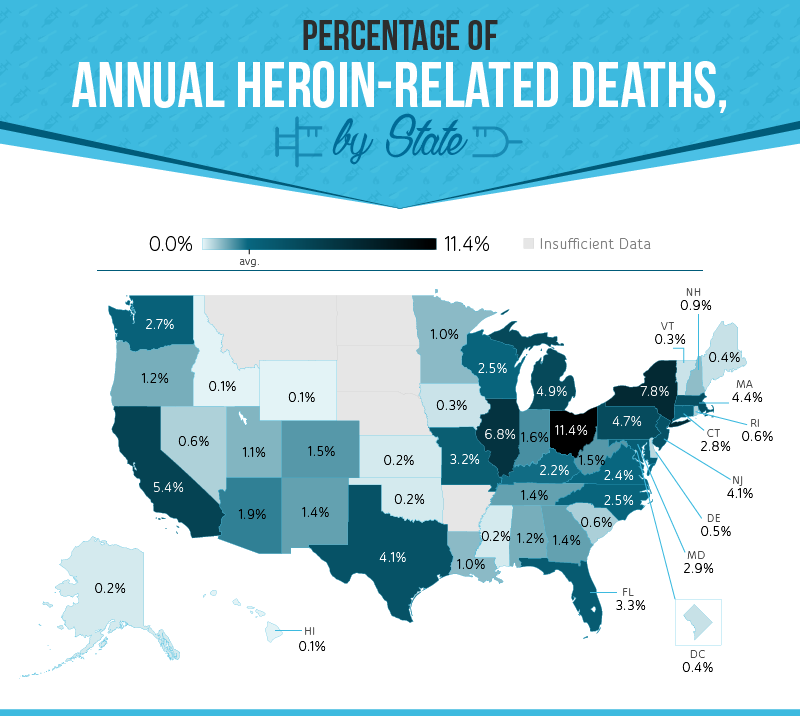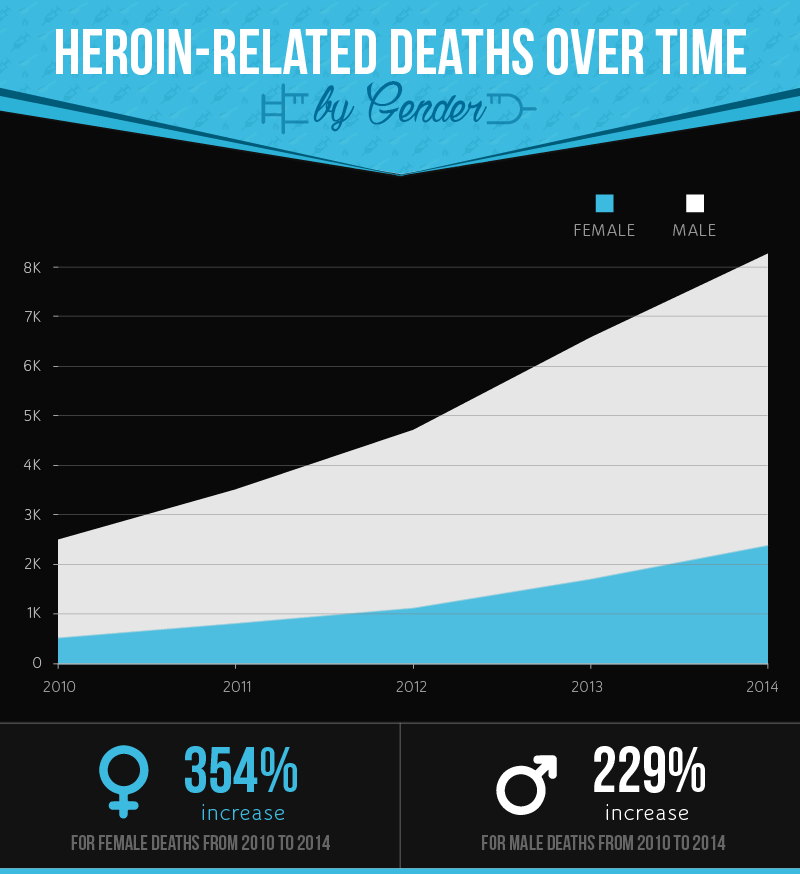Across the United States, a rising death toll offers tragic proof of heroin's deadly reach. This powerfully addictive and dangerous street drug, previously limited to major inner-city areas in decades past, has now made its way to suburbs throughout the nation. Partly fueled by the overprescribing and abuse of opioid painkillers such as OxyContin throughout the 2000s, illicit heroin has become a common alternative for painkiller users following the crackdown on these prescription drugs. In recent years, over 900,000 Americans report having used heroin over the past year, with nearly 300,000 heroin users being admitted for substance abuse treatment. For some, the outcome of heroin use will ultimately be fatal: in 2013 alone, over 8,200 people died of heroin overdoses. The tragic impact of this drug has now become an everyday reality. As one town reported: “There’s not enough room to keep all the bodies.”
The nation’s heroin epidemic is an ongoing crisis, with the DEA declaring heroin to be the country’s top drug threat. So what does the impact of heroin look like in real time? We’ve created a tool that tracks the rates of emergency room visits and deaths as a result of
 heroin use. It includes ER visits in several major cities as well as deaths by gender and age group. With this interactive tool, you can see the serious and even fatal impact of heroin use in the United States over a week, a month, and a year. Keep reading to learn more about the deadly effects of heroin across the nation.
heroin use. It includes ER visits in several major cities as well as deaths by gender and age group. With this interactive tool, you can see the serious and even fatal impact of heroin use in the United States over a week, a month, and a year. Keep reading to learn more about the deadly effects of heroin across the nation.
The map above represents each state’s proportion of the nation’s recorded heroin fatalities in 2014. The national median proportion of fatalities in each state is 1.3 percent, and many states report a percentage of fatalities that’s several times greater.
Ohio is home to 1 in 9 of the nation’s fatalities. In fact, Dayton, Ohio -- an unlikely midsize Midwestern city -- has become an epicenter for direct deliveries of internationally trafficked heroin. Here, dealers are known to distribute small packets of the drug as “samples” alongside other street drugs such as crack cocaine. As a result, more people are getting hooked on heroin, thus increasing its demand. This greater availability of heroin has been identified as one of the primary causes of an increasing number of deadly heroin overdoses in the state. Fentanyl, another powerful opioid that has sometimes been mixed with heroin, has also been implicated in Ohio overdoses. As heroin users may be less familiar with fentanyl and its effects, the risk of an accidental overdose is much greater.
The state of New York was host to 7.8 percent of the nation’s heroin-related fatalities, and the Northeast region – including Pennsylvania (4.7 percent), Massachusetts (4.4 percent), and New Jersey (4.1 percent) – has recently seen a rise in heroin use that’s reached epidemic proportions. New York authorities regularly seize large quantities of trafficked heroin, while the New Jersey State Police note that the Garden State is home to some of the purest heroin in the country, as a result of direct importation from Colombia. A higher purity can also mean an elevated risk of unintentional overdose. In response to the addiction crisis, many authorities have called for increased availability of rehab facilities and medication-assisted treatment to help heroin users get sober.

The scale of heroin-related deaths can be shocking – in 2014, Ohio and New York alone accounted for nearly 2,100 deaths. Additionally, Illinois reported 734 heroin-related fatalities and the Chicago metropolitan area was first in the nation for heroin-related ER visits. In recent years, heroin use among youth and women living in Illinois has dramatically increased, with heroin use by youth showing an increase of more than 50 percent in six years. Unfortunately, the state’s capacity for handling heroin addiction treatment admissions has been declining, leaving individuals with fewer opportunities to receive substance abuse treatment.
 California places fourth with 578 recorded heroin deaths; in 2013, the state also saw over 11,500 patients being treated for overdosing. Heroin is reported to be widely available at low prices throughout California, with its spread being driven by the greater price and unavailability of prescription painkillers such as OxyContin.
California places fourth with 578 recorded heroin deaths; in 2013, the state also saw over 11,500 patients being treated for overdosing. Heroin is reported to be widely available at low prices throughout California, with its spread being driven by the greater price and unavailability of prescription painkillers such as OxyContin.
Meanwhile, Michigan – a state described as a pipeline for heroin trafficked to other Midwestern states – ranked fifth with 529 heroin deaths. In 2013, 1 in every 4 drug overdoses in the state were linked to heroin. Michigan police are working to take heroin off the streets, and an increasing number of police agencies now provide officers with naloxone, a drug that can rapidly reverse potentially fatal heroin overdoses.


While heroin use has proliferated across the country, not everyone is equally affected. Heroin-related deaths occur nearly three times more in men than women, a pattern which has held true for years. Yet deaths among women are rising at a much faster rate – from 2010 to 2014, male deaths increased by 229%, whereas female deaths increased by 354%. A number of factors can contribute to this difference: women tend to have chronic pain more frequently than men and are prescribed more opioid painkillers for longer durations and in higher doses. This could leave them especially vulnerable to switching to heroin. They may also develop addiction and dependency faster than men. Today, about half of heroin users are women, and their greater difficulty in quitting and increased chance of relapse can put them at additional risk.
Finding Help to Beat Heroin Addiction
The deadly toll of heroin continues to run rampant across the country, with more than one death occurring every hour. And for every recorded death, far more are grappling with their addiction every day. Faced with an influx of easily available heroin in cities and suburbs throughout the nation, users can find it more difficult than ever to kick the habit. If you or someone you know is struggling with substance use, Heroin.net can help. We can connect you to professional treatment services such as rehab, detox, and therapy programs, provided by medical experts and tailored to meet your needs. Call Heroin.net today at 1-888-496-8059, and start reclaiming your life from addiction.
Methodology
Rates for heroin-related emergency room visits and deaths were calculated based on latest annual figures from SAMHSA.gov, DrugAbuse.gov, and CDC.gov.
Sources
- http://www.samhsa.gov/data/emergency-department-data-dawn/reports
- https://www.drugabuse.gov/related-topics/trends-statistics/overdose-death-rates
- http://wonder.cdc.gov/
- http://www.cdc.gov/media/releases/2015/p1218-drug-overdose.html
- http://www.usnews.com/news/blogs/data-mine/2015/07/07/heroin-use-skyrockets-in-us-cdc-says
- http://time.com/3946904/heroin-epidemic/
- http://www.washingtonpost.com/sf/national/2015/09/24/pellets-planes-and-the-new-frontier/
- http://news.psu.edu/story/375720/2015/10/19/research/probing-question-what-behind-americas-heroin-epidemic
- http://www.samhsa.gov/data/sites/default/files/NSDUH-DetTabs2014/NSDUH-DetTabs2014.htm#tab1-1a
- http://www.samhsa.gov/data/sites/default/files/2012_Web_Tables_as_of_2014_Q4/TEDS_2012_Substance_Abuse_Treatment_Admissions_Tables.html#US12
- http://www.cdc.gov/vitalsigns/heroin/
- http://www.nbcnews.com/news/us-news/dea-finds-heroin-use-skyrocketing-n457336
- http://mha.ohio.gov/portals/0/assets/research/reports/heroinoverdosereportfin43014.pdf
- http://www.healthy.ohio.gov/~/media/HealthyOhio/ASSETS/Files/injury%20prevention/2014%20Ohio%20Preliminary%20Overdose%20Report.pdf
- http://newyork.cbslocal.com/2016/03/03/tri-state-area-heroin-epidemic/
- http://www.nbcnews.com/health/health-news/heroin-deaths-quadruple-across-us-n388006
- http://www.roosevelt.edu/News_and_Events/News_Articles/2015/20150811-HeroinCrisis.aspx
- http://www.sacbee.com/site-services/databases/article31324532.html
- http://legacy.abc10.com/story/news/health/2014/02/04/heroin-epidemic-california-treatment/5198759/
- http://www.freep.com/story/news/local/michigan/2015/08/26/feds-michigan-drug-pipeline-heroin-resurgence/32412437/
- http://bridgemi.com/2015/09/in-michigan-heroin-epidemic-deciding-whose-lives-are-worth-saving/
- http://www.wnem.com/story/27491823/heroin-becomes-epidemic-in-mid-michigan-hometowns
- http://www.asam.org/docs/default-source/advocacy/opioid-addiction-disease-facts-figures.pdf
- http://www.theverge.com/2014/5/28/5758552/heroin-user-demographics-young-white-adults
- http://www.theatlantic.com/health/archive/2015/07/women-heroin/397922/

